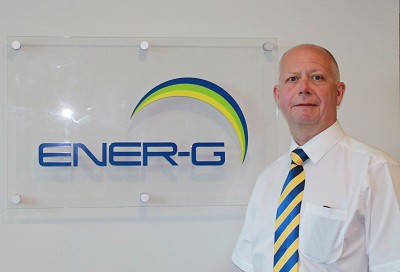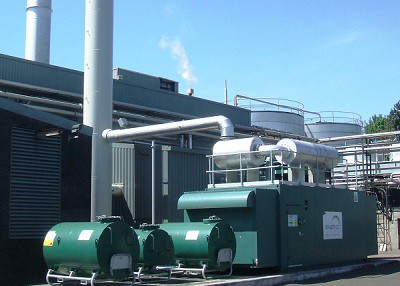Anaerobic digestion can be financially attractive for organisations with a ready source of organic waste feedstock to fuel the technology.

As such, the technology is particularly suitable for farmers and energy-intensive manufacturers and processors, such as those in the food and drink sector and paper industry. Availability of at least a ten-year feedstock supply is a prime requirement in ensuring financial viability of anaerobic digestion projects and delivering healthy returns.
According to Defra, the UK produces approximately seven million tonnes of food waste and 90 million tonnes of animal slurry and manure each year that could be used for anaerobic digestion.
The anaerobic digestion process releases a methane-rich gas called biogas, which is converted into renewable energy in the form of electricity and heat using combined heat and power (CHP). By utilising this renewable energy, developers can maximise system efficiency and increase income streams.
Five key financial benefits of anaerobic digestion
1. Renewable energy savings – from displacing existing fossil-fuelled supplies;
2. Operational savings on waste disposal – by turning a liability into an asset, negating landfill tax charges or sharply rising effluent costs;
3. Cost savings – by using the digestate by-product of anaerobic digestion, or revenue from selling the digestate, e.g. as an organic fertiliser;
4. Financial benefits – from reducing carbon footprint, e.g. avoidance of green taxes and fines for non-compliance with energy saving targets;
5. Government financial incentives – these are:
a. Feed-in-Tariff (FiT) – a fixed 20-year income for renewable electricity generation used on-site or exported to the grid.
b. Renewables Obligation Certificates (ROCs) – for renewable electricity generation, which are a less popular alternative to FiTs.
c. Renewable Heat Incentive (RHI) – a fixed 20-year income for renewable heat generation – available both for biogas combustion from anaerobic digestion and biomethane injection, where the biogas is upgraded to biomethane and fed directly into the gas grid.
d. Road Transport Fuel Certificates (RTFCs) – tradeable certificates for biomethane fuel.

Government Financial Incentives
In this article we focus on the government funding that can ensure the viability and accelerate the payback on anaerobic digestion.
In the July 2015 budget the Chancellor announced that renewable electricity will no longer be exempt from the Climate Change Levy, but there are other attractive incentives available to help make up for this shortfall. These are:
1. Renewable electricity incentives
For electrical generation between 50kW and 5MW, developers can select from either FiTs or ROCs, but most developers select FiTs.
a. Feed-in Tariffs (FiTs) provide a guaranteed income for renewable electricity generation over 20 years. A generation tariff is available for every kWh of electricity generated. This varies depending on the size of the plant and whether the power is used on-site or exported to the National Grid.
Income for renewable electricity generation used on-site (up to 30 September 2015):
Anaerobic digestion total installed capacity – up to 249kW – 10.13p per kWh
Anaerobic digestion total installed capacity – 250kW to 499kW – 9.36p per kWh
Anaerobic digestion total installed capacity – 500kW to 5MW- 8.68p per kWh
Income for renewable electricity exported to National Grid:
Electricity exported to the grid can receive a minimum 4.85p/kWh – but it’s negotiable with the electricity supplier, which could result in payments of up to 6p/kWh.
b. Renewable Obligation Certificates (ROCs) – these are tradeable certificates for renewable electricity generation and rates vary with market forces. An anaerobic digester is currently eligible for 1.9 ROCs/MWh at a current value of 9.6p/kWh.
2. Non-Domestic Renewable Heat Incentive (RHI):
The RHI provides a fixed 20-year income per kWh to generators of renewable heat and producers of renewable biogas and methane. Often the heat captured is used on the anaerobic digestion site to maintain the temperature in the digesters. This heat does not attract any payments through the RHI. However, the heat can also be used for buildings and low temperature hot water elsewhere on the site. For organisations, particularly farms, that are reliant on expensive oil-fired heating systems, this can be an attractive option.

Non-domestic Renewable Heat Incentive for anaerobic digestion – current tariff
Biogas combustion up to 199kWth – 7.62p/kWh
Biogas combustion from 200-599kWth – 5.99p/kWh
Biogas combustion over 600kWth – 2.24p/kWh
Non-domestic Renewable Heat Incentive for biomethane injection – current tariff
First 40,000 MWh of eligible biomethane (tier one) 7.24p/kWh
Next 40,000 MWh of eligible biomethane (tier two) 4.25p/kWh
Remaining MWh of eligible biomethane (tier three) 3.28p/kWh
3. Road Transport Fuel Certificates (RTFCs)
Biogas can also be upgraded as transport fuel. Tradeable certificates are payable for such biomethane fuel. At the current rate, 1.9 RTFCs are issued per kg fuel supplied – at a value of 7.5p/kg.
Time sensitivity of financial incentives
Time is of the essence in optimising government incentives. The FiT and RHI tariffs present a fixed income for the life of the installation, but these tariffs are subject to a biannual degression which reduces returns on projects.
Tariff degression was introduced in 2012 as a cost control measure. The degression mechanism means that tariffs available to new generators across all technologies reduce automatically over time without the need for a formal tariff review. As well as set “baseline” degressions, additional tariff reductions are contingent on deployment levels.
‘Locking in’ to these tariffs can negate degression, making it essential to act in a timely manner since it may take a year to plan and install biogas plant. Pre-accreditation ‘lock in’ is currently possible, but this depends on successful planning approval and an agreed electricity connection (which can take three to four months). The government is currently consulting on its proposal to remove pre-accreditation and pre-registration from the FIT scheme, which will mean that tariffs can only be set at the later date of application for full accreditation.
Funding for on-farm anaerobic digestion projects
Government R&D grants are available to farmers who want to assess viability of anaerobic digestion. This fund is available to farms in England who have access to manures and slurries and who wish to build AD plants producing up to 250kWe of power. The fund has a rolling application process, so submissions are welcomed at any time.
Also available to farmers in England is the On-Farm Anaerobic Digestion Loan, a fund which offers access to finance of up to £400k for plants generating under 250kWe.
Conclusion
Given the right mix of feedstock, scale and technology, payback on anaerobic digestion can be as quick as five to seven years. Anaerobic digestion can also provide energy security, create additional revenues, reduce input costs and help stabilise your business for the future.
For the past 30 years, ENER-G has been European market leader in small scale CHP (4kWe to over 10MWe). The company has developed over 170MW of biogas power generation from anaerobic digestion, landfill, and associated gases. ENER-G provides a complete package – from design and manufacture of CHP systems – to installation, commissioning and finance – through to maintenance and service via its national engineering team. It also supplies pre-treatment technology required to clean and dry biogas from digestion processes, such as effluent and anaerobic digestion.
Further information: www.energ.co.uk/chp










Subscribe for free